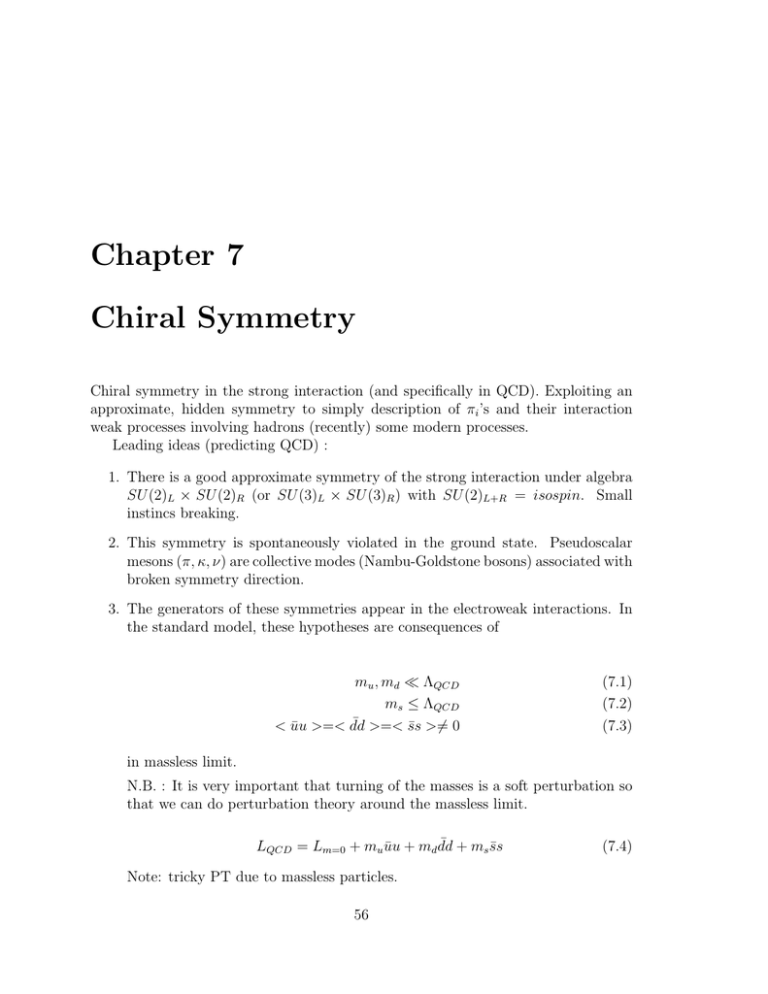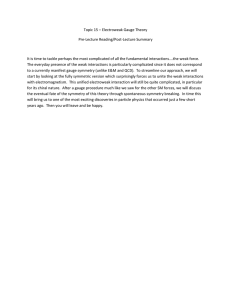Document 13650512
advertisement

Chapter 7 Chiral Symmetry Chiral symmetry in the strong interaction (and specifically in QCD). Exploiting an approximate, hidden symmetry to simply description of πi ’s and their interaction weak processes involving hadrons (recently) some modern processes. Leading ideas (predicting QCD) : 1. There is a good approximate symmetry of the strong interaction under algebra SU (2)L × SU (2)R (or SU (3)L × SU (3)R ) with SU (2)L+R = isospin. Small instincs breaking. 2. This symmetry is spontaneously violated in the ground state. Pseudoscalar mesons (π, κ, ν) are collective modes (Nambu-Goldstone bosons) associated with broken symmetry direction. 3. The generators of these symmetries appear in the electroweak interactions. In the standard model, these hypotheses are consequences of mu , md � ΛQCD ms ≤ ΛQCD ¯ < uu ¯ >=< dd >=< ss ¯ >= � 0 (7.1) (7.2) (7.3) in massless limit. N.B. : It is very important that turning of the masses is a soft perturbation so that we can do perturbation theory around the massless limit. ¯ + ms ss LQCD = Lm=0 + mu uu ¯ + md dd ¯ Note: tricky PT due to massless particles. 56 (7.4) 7.1. HISTORY AND SKETCH OF EXAMPLE APPLICATION 57 The specific realization in QCD is more powerful: (a) Link to PQCD – corrections (b) Concrete realization of breaking i. L1 transforms as (3, ¯ 3) + (3̄, 3) under SU (3)L × SU (3)R ii. Contributions from anomalies as mentions above. 7.1 History and Sketch of Example Application Goldberger-Treiman formula (1957) gA M N (7.5) fπ This works well, but their derivation was cheesy. Nambu (1960-62) relate to approximate symmetry and correlate with lightness of π mesons. gπN N = < O|jµs |π > ∼ fπ pµ (measured in π → µν) < O|∂j|π > ∼ < n|jµs |π > = 0 = = fπ p2 = fπ m2π ≈ 0 gA u(n)γ ¯ 1 γµ u(p) (+P.S.) < n|jµs |π > gA MN − fπ gπN N � �� � direct � �� � π pole f π m 2π π 1 2 mπ gπNN Direct π Pole Figure 7.1: Goldberger-Treiman. ⇒ Goldberger-Treiman. This is the tip of an iceberg of applications, as alluded to above. (7.6) (7.7) (7.8) (7.9) (7.10) 58 CHAPTER 7. CHIRAL SYMMETRY 7.2 Meson Masses, UA(1) Problem Standard (Gellmann – Oakes – Ronne) GM-O-R → (Gellmann – Okulbo) GM-O will discuss this using effective Lagrangian with < ḡLi , gRj >= νδij (7.11) there are low-energy states associated with slow motion in the vacuum manifold < ḡLi (x), gRj (x) >= νΣji (x) (Σ ∈ SU (3)) (7.12) Write ZiM ) f π◦ √ + √n6 π+ 2 ◦ π π− −√ + 2 − ¯ K ◦ K Σ = exp( ⎛ ⎜ M = ⎜ ⎝ L = fū2 tr∂ µ Σ+ ∂µ Σ 8 (7.13) √n 6 ⎞ K+ ⎟ K◦ ⎟ ⎠ 2n −√ 6 (7.14) (7.15) gives the properly normalized axial current. Note SU (3)L+R f lavor symmetryΣ → U + ΣU SU (3)L × SU (3)R Σ → U + ΣU (7.16) + + ΔL ≡ υT r(m+ q Σ + mq Σ ) + highness in ∂, m (7.17) No potential is allowed, since ΣΣ+ = 1, detΣ = 1. Quark masses likewise transform as U + MV (since they go with ḡLi gRj ). So with ⎛ mu ⎜ M = ⎝ md ms 2 ΔL = − ⎛ π ◦2 2 ⎜ 4υ ⎜ 0 tr f2 ⎝ ⎞ ⎟ ⎠ n2 6 (7.18) ◦ ◦ ⎞ + π + π − + K + K − + π√n3 0 0 ⎟ ◦ n◦ π ◦2 n2 π√ + − ◦ ◦ ⎟ + + π π + K K̄ + 0 ⎠ 2 6 3 2 2 + − ◦ ¯◦ 0 0 3n + K K + K K + 7.2. MESON MASSES, UA (1) PROBLEM ⎛ m2π◦ π◦ = m2ηη = m2π◦ η = m2K + K − = m2K ◦ K¯◦ = mu ×⎜ ⎝ md ms 59 ⎞ ⎟ ⎠ (7.19) 4υ 2 (mu + md ) f2 4υ 2 mu + md 4ms ( + ) f2 3 3 4υ 2 mu − md √ f2 3 2 4υ (mu + ms ) f2 4υ 2 (md + ms ) f2 (7.20) (7.21) (7.22) (7.23) (7.24) Phenomenologically: m u , m d � ms (7.25) mu − md is not much smaller than mu + md . It is still rather poorly determined. Gets mixed up with QED corrections. Probably mu ≈ 0.4 md 1 mu + md ≈ ms 25 (7.26) (7.27) d π − n mixing is ∼ mum+m . s From all this we get 2 2 3m2η + m2π◦ = 2(mK + + mK ◦ ) (7.28) which works very well. However, if we include a singlet ⎛ ⎜ M = ⎜ ⎝ σ+ √n 6 σ+ √n 6 ⎞ σ− 2n √ 6 ⎟ ⎟ ⎠ (7.29) 2n however normalized, σ − √ gets no contribution from ms ⇒ extra light pseu6 doscalar mesons Has not been seen (n� won’t do). This is the UA (1) problem.




